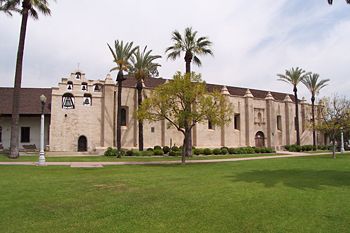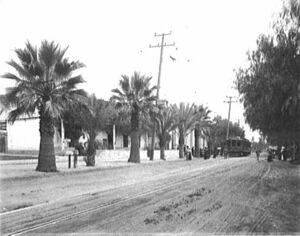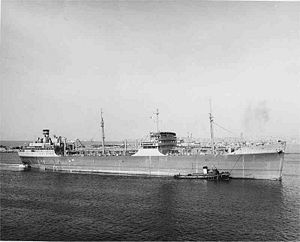Mission San Gabriel Arcángel: Difference between revisions
imported>Robert A. Estremo No edit summary |
imported>Robert A. Estremo mNo edit summary |
||
| Line 54: | Line 54: | ||
|- | |- | ||
|<small>'''Neophyte Population:''' | |<small>'''Neophyte Population:''' | ||
|1,701 <ref>Engelhardt | |1,701 <ref>Engelhardt 1915, p. 529: 1817 saw the greatest number of neophytes attached to the Mission.</ref> | ||
|- | |- | ||
!colspan="2" style="color: black; height: 30px; background: #C96;"| DISPOSITION | !colspan="2" style="color: black; height: 30px; background: #C96;"| DISPOSITION | ||
Revision as of 12:37, 22 October 2012
 A view of Mission San Gabriel Arcángel in April, 2005.[1] The open stairway at the far right leads to the choir loft, and to the left is the six-bell campanario (bell wall) that was built after the original bell structure, located at the far end of the church, toppled during the Wrightwood Earthquake of 1812. A view of Mission San Gabriel Arcángel in April, 2005.[1] The open stairway at the far right leads to the choir loft, and to the left is the six-bell campanario (bell wall) that was built after the original bell structure, located at the far end of the church, toppled during the Wrightwood Earthquake of 1812.
| |
| HISTORY | |
|---|---|
| Location: | San Gabriel, California |
| Name as Founded: | La Misión del Santo Príncipe El Arcángel, San Gabriel de Los Temblores [2] |
| English Translation: | The Mission of the Saintly Prince The Archangel, St. Gabriel of the Tremblors |
| Patron Saint: | Gabriel, Holy Prince of Archangels [3] |
| Nickname(s): | "Pride of the Alta California Missions" "Mother of Agriculture in California" [4] |
| Founding Date: | September 8, 1771 [5] |
| Founded By: | Fathers Pedro Cambón and Angel de la Somera (1st); Father Presidente Junípero Serra (2nd) [6] |
| Founding Order: | Fourth [3] |
| Military District: | First [7][8] |
| Native Tribe(s): Spanish Name(s): |
Tongva [5] Gabrieliño [5] |
| Native Place Name(s): | 'Iisanchanga, Shevaanga [9] |
| SPIRITUAL RESULTS | |
| Baptisms: | 7,825 [10] |
| Confirmations: | 4,269 [11] |
| Marriages: | 1,916 [10] |
| Burials: | 5,670 [10] |
| Neophyte Population: | 1,701 [12] |
| DISPOSITION | |
| Secularized: | 1834 [3] |
| Returned to the Church: | 1859 [3] |
| Governing Body: | Roman Catholic Diocese of Los Angeles |
| Current Use: | Chapel / Museum |
| Coordinates: | 34°5′34″N, 118°6′43″W |
| National Historic Landmark: | NPS–71000158 |
| Date added to the NRHP: | 1971 |
| California Historical Landmark: | #158 |
| Web Site: | http://www.sangabrielmission.org |
Mission San Gabriel Arcángel was founded on "The Feast of the Birth of the Blessed Virgin Mary" (September 8), 1771, the fourth in the twenty-one mission Alta California chain established by Spanish Catholics of the Franciscan Order. Site of the first hospital in Alta California, the settlement is historically referred to as the "Godmother of the Pueblo of Los Angeles." The chapel was designed by Father Antonio Cruzado (who hailed from Córdoba, Spain, which accounts for the strong Moorish influence).
Precontact
The current prevailing theory postulates that Paleo-Indians entered the Americas from Asia via a land bridge called "Beringia" that connected eastern Siberia with present-day Alaska (when sea levels were significantly lower, due to widespread glaciation) between about 15,000 to 35,000 years ago. The remains of Arlington Springs Man on Santa Rosa Island are among the traces of a very early habitation in California, dated to the last ice age (Wisconsin glaciation) about 13,000 years ago. The first humans are therefore thought to have made their homes among the southern valleys of California's coastal mountain ranges some 10,000 to 12,000 years ago; the earliest of these people are known only from archaeological evidence.[13] The cultural impacts resulting from climactic changes and other natural events during this broad expanse of time were negligible; conversely, European contact was a momentous event, which profoundly affected California's native peoples.[14]
History
The mission was founded on September 8, 1771. The planned site for the Mission was along the banks of the Río de los Temblores (the River of the Earthquakes — the Santa Ana River). However, the priests chose an alternate site on a fertile plain located directly alongside the Rio Hondo in the Whittier Narrows.[15] The site of the Misión Vieja (or "Old Mission") is located near the intersection of San Gabriel Boulevard and Lincoln Avenue in Montebello, California (known to the natives as Shevaanga). In 1776, a flash flood destroyed much of the crops and ruined the Mission complex, which was subsequently relocated five miles closer to the mountains in present-day San Gabriel (the native settlement of 'Iisanchanga). The Mission is the base from which the pueblo that became the City of Los Angeles, was sent. On December 8, 1812 (the "Feast Day of the Immaculate Conception of the Blessed Virgin") a series of massive earthquakes shook Southern California. The 1812 Wrightwood Earthquake caused the three-bell campanario, located adjacent to the chapel's east façade, to collapse. A larger, six-bell structure was subsequently constructed at the far end of the capilla. While no pictorial record exists to document what the original structure looked like, architectural historian Rexford Newcomb deduced the design and published a depiction in his 1916 work The Franciscan Mission Architecture of Alta California.
Legend has it that the founding expedition was confronted by a large group of native Shoshone peoples whose intention was to drive the strangers away. One of the padres laid a painting of "Our Lady of Sorrows" on the ground for all to see, whereupon the natives (known to the settlers as the Gabrieliños) immediately made peace with the missionaries, so moved were they by the painting's beauty.[2] Today the 300-year-old piece hangs in the Mission's reredos (sanctuary). A large stone cross stands in the center of the campo santo (cemetery), first consecrated in 1778 and then again on January 29, 1939 by Los Angeles Archbishop John Cantwell. It serves as the final resting place for some 6,000 "neophytes;" a small stone marker denotes the gravesite of José de Los Santos, the last native to be buried on the grounds at the age of 101 in February, 1921. Also interred at the Mission are the bodies of numerous padres who died during their time of service, as well as the remains of Reverend Raymond Catalan, C.M.F., who undertook the restoration of the Mission's gardens. Entombed at the foot of the altar are the remains of eight Franciscan priests (listed in order of interment): Father Miguel Sánchez, Father Antonio Cruzado, Father Francisco Dumetz, Father Roman Ulibarri, Father Joaquin P. Nuez, Father Gerónimo Boscana, Father José Bernardo Sánchez, and Father Blas Ordaz. Buried among the padres is centenarian Eulalia Perez de Guillén Mariné, the "keeper of the keys" under Spanish rule; her grave is marked by a bench dedicated in her memory.

Artist Rexford Newcomb's rendition of Mission San Gabriel Arcángel's original campanile, or bell tower. The details are similar to those of the chapel at Mission Santa Inés.[16]
Well over 25,000 baptisms were conducted at San Gabriel between 1771 and 1834, making it the most prolific in the mission chain. In its heyday it furnished food and supplies to settlements and other missions throughout California. A majority of the Mission structures fell into ruins after it was secularized in November 1834. The Mission's chapel functioned as a parish church for the City of San Gabriel from 1862 until 1908, when the Claretian Missionary Fathers came to San Gabriel and began the job of rebuilding and restoring the Mission. On October 1, 1987 the Whittier Narrows Earthquake further damaged the property. A significant portion of the original complex has since been restored.
Other historic designations
- California Historical Landmark #161 — site of "Mission Vieja"
- Los Angeles Conservancy Preservation Award (1994) — "Seismic retrofit and restoration of The oldest building in Los Angeles County"
- Daughters of the American Revolution (1968) — "The Oldest Building in Southern California of Brick, Stone and Mortar"
Mission industries
The goal of the missions was, above all, to become self-sufficient in relatively short order. Farming, therefore, was the most important industry of any mission. Prior to the establishment of the missions, the native peoples knew only how to utilize bone, seashells, stone, and wood for building, tool making, weapons, and so forth. The missionaries discovered that the Indians, who regarded labor as degrading to the masculine sex, had to be taught industry in order to learn how to be self-supportive. The result was the establishment of a great manual training school that comprised agriculture, the mechanical arts, and the raising and care of livestock. Everything consumed and otherwise utilized by the natives was produced at the missions under the supervision of the padres; thus, the neophytes not only supported themselves, but after 1811 sustained the entire military and civil government of California.[17]
Mission bells
Bells were vitally important to daily life at any mission. The bells were rung at mealtimes, to call the Mission residents to work and to religious services, during births and funerals, to signal the approach of a ship or returning missionary, and at other times; novices were instructed in the intricate rituals associated with the ringing the mission bells.
Notes

A streetcar of the Pacific Electric Railway makes a stop at Mission San Gabriel Arcángel circa 1905.

USNS Mission San Gabriel (T-AO-124) was the fourteenth of twenty-seven Mission Buenaventura-class fleet oilers built during World War II for service in the United States Navy. Scrapped in 1975, she was the only U.S. Naval vessel to have borne the name.[18]
- ↑ (CC) Photo: Robert A. Estremo
- ↑ 2.0 2.1 Leffingwell, p. 43 Cite error: Invalid
<ref>tag; name "leffingwell43" defined multiple times with different content - ↑ 3.0 3.1 3.2 3.3 Krell, p. 113
- ↑ Ruscin, p. 41
- ↑ 5.0 5.1 5.2 Yenne, p. 48
- ↑ Ruscin, p. 196
- ↑ Forbes, p. 202
- ↑ Engelhardt 1920, pp. v, 228: "The military district of San Diego embraced the Missions of San Diego, San Luis Rey, San Juan Capistrano, and San Gabriel..."
- ↑ Ruscin, p. 195
- ↑ 10.0 10.1 10.2 Krell, p. 315: as of December 31, 1832; information adapted from Engelhardt's Missions and Missionaries of California.
- ↑ Sugranes, p. 72
- ↑ Engelhardt 1915, p. 529: 1817 saw the greatest number of neophytes attached to the Mission.
- ↑ Paddison, p. 333: The first indisputable archaeological evidence of human presence in California dates back to circa 8,000 BCE.
- ↑ Jones and Klar 2005, p. 53: "Understanding how and when humans first settled California is intimately linked to the initial colonization of the Americas."
- ↑ McCawley, p 189
- ↑ Baer, p. 127
- ↑ Engelhardt 1922, p. 211
- ↑ Mission San Gabriel
